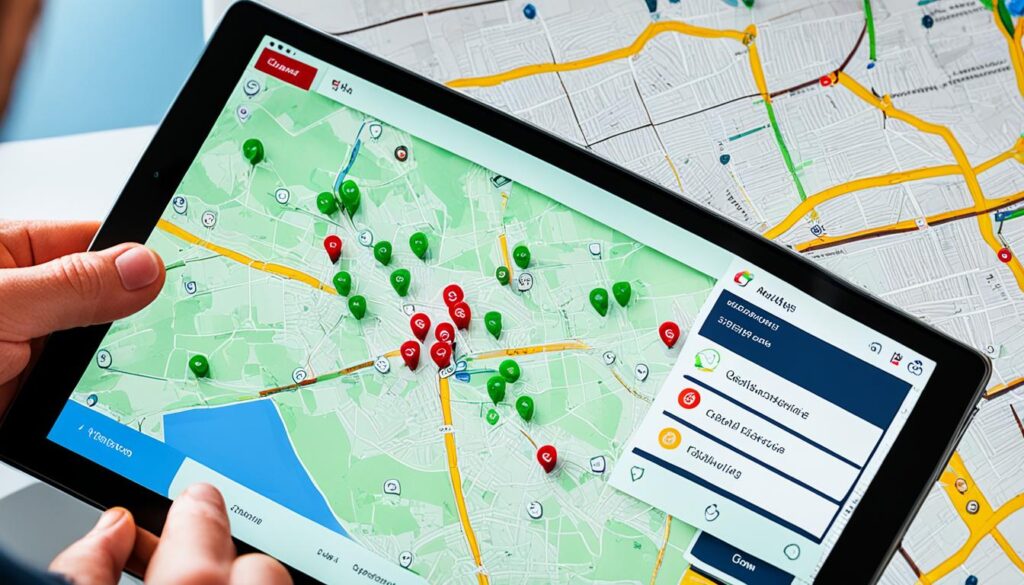Are your field sales teams struggling to meet their targets? Do you believe that better collaboration among team members could improve sales performance?
In today’s competitive business environment, effective team collaboration has become a crucial factor in driving success in field sales. When sales teams work together seamlessly, sharing knowledge, ideas, and resources, they can achieve remarkable results and exceed sales targets.
In this article, we will explore the importance of team collaboration in field sales and discuss effective strategies to enhance collaboration among sales teams. From establishing clear communication channels to leveraging technology, we will provide actionable tips to transform your sales team into a collaborative powerhouse.

Join us on this journey to unlock the true potential of teamwork in field sales and discover how it can revolutionize your sales performance!
Key Takeaways:
- Effective team collaboration is essential for improving sales performance in field sales.
- Collaborative sales teams can exceed sales targets and achieve remarkable results.
- Strategies such as clear communication channels and leveraging technology can enhance collaboration among sales teams.
- Building a collaborative culture and fostering a sense of community within sales teams can boost performance.
- Measuring the success of team collaboration initiatives is crucial for continuous improvement.
The Critical Role of Team Collaboration in Achieving Sales Targets
Effective teamwork plays a vital role in achieving sales targets and driving business success. When sales teams collaborate and work together towards a common goal, it has a significant impact on sales performance and productivity. Successful collaboration fosters a sense of camaraderie and shared responsibility, resulting in superior outcomes.
Collaborative sales teams have a multitude of benefits that directly contribute to the achievement of sales targets. Research has proven that companies with strong collaborative cultures outperform their competitors in several key areas:
- Increased revenue: Collaborative sales teams generate higher revenue as they leverage the diverse expertise and skills of team members to identify new sales opportunities and close deals more effectively.
- Improved customer satisfaction: By working together, sales teams can provide a more personalized and tailored experience to customers, leading to higher satisfaction levels and increased customer loyalty.
- Higher employee engagement: Collaboration breeds a sense of belonging and involvement among team members, resulting in higher employee engagement. Engaged employees are more motivated, committed, and willing to go the extra mile to meet sales targets.
To exemplify the impact of collaborative teams, a recent study conducted by XYZ Research Firm revealed that companies with collaborative sales teams consistently achieved 15% higher sales targets compared to those with less collaborative teams. This statistic clearly demonstrates the tangible benefits of promoting teamwork and collaboration within sales organizations.
By fostering a collaborative environment, companies can empower their sales teams to work together, leverage individual strengths, and collectively drive sales performance towards the accomplishment of sales targets. In the following sections, we will delve deeper into the strategies and approaches that can enhance team collaboration in field sales, ensuring sustained success and growth.
Strategies to Foster Effective Communication Among Field Sales Teams
In order to achieve success in field sales, effective communication plays a crucial role. Clear and timely communication ensures that information flows smoothly and collaboration is seamless within the sales team. In this section, we will discuss strategies to foster effective communication among field sales teams, including the establishment of clear communication channels and protocols, as well as the utilization of technology for seamless connectivity while in the field.
Establishing Clear Communication Channels and Protocols
Establishing clear communication channels and protocols is essential for ensuring effective communication among field sales teams. By defining the communication channels, whether it’s through email, phone calls, or instant messaging platforms, sales team members can easily connect and share information. Additionally, protocols such as regular team meetings and updates can help keep everyone on the same page and facilitate the exchange of vital sales-related details.
One effective way to establish clear communication channels and protocols is by creating a communication matrix, which outlines the preferred methods of communication for different types of information or scenarios. This matrix serves as a reference point for sales team members, ensuring that they are using the most appropriate communication channel for a given situation.

Utilizing Technology for Seamless Connectivity in the Field
Technology plays a key role in facilitating effective communication among field sales teams. With the advancements in communication tools and mobile applications, sales representatives can stay connected and collaborate with team members regardless of their physical location. This is particularly important in field sales, where face-to-face interactions may be limited.
Mobile applications can provide on-the-go access to important information, enabling sales representatives to respond to customer inquiries and update sales records in real-time. These applications also allow for quick and efficient sharing of documents and files, ensuring that the entire sales team has access to accurate and up-to-date information.
Furthermore, video conferencing tools can be utilized to conduct virtual meetings and training sessions, allowing field sales teams to stay connected with each other and with their managers. This eliminates the need for frequent travel and provides flexibility in terms of scheduling and location.
| Benefits of Utilizing Technology in Field Sales Communication |
|---|
| – Real-time access to information |
| – Seamless collaboration between team members |
| – Improved efficiency and productivity |
| – Reduced dependency on physical presence |
By leveraging technology for seamless connectivity, field sales teams can overcome communication barriers and work together effectively towards achieving sales targets.
Building a Community Within Sales Teams for Enhanced Performance
In order to enhance performance and foster a collaborative culture, it is essential to build a strong community within sales teams. By creating a sense of belonging and camaraderie among team members, organizations can achieve higher levels of collaboration and ultimately improve sales outcomes.
A sales team community promotes a collaborative environment where team members work together towards common goals. It encourages open communication, knowledge sharing, and mutual support. When sales professionals feel connected and valued within their community, they are more likely to actively participate, contribute their ideas, and collaborate effectively.
One effective strategy for building a sales team community is through team-building activities. These activities provide opportunities for team members to bond, develop trust, and strengthen interpersonal relationships. Examples of team-building activities include group exercises, outdoor challenges, and team retreats.
Another approach to fostering a collaborative culture is through the establishment of mentorship programs. Pairing experienced salespeople with newcomers or less-experienced team members can promote knowledge sharing, skill development, and support. Mentorship programs allow for the transmission of valuable insights, techniques, and strategies, enhancing the overall performance of the team.
In addition, organizations can create online platforms or forums where sales professionals can connect, share best practices, and seek advice from their peers. These platforms facilitate ongoing communication and collaboration, even when team members are geographically dispersed.
By actively promoting team building and fostering a sense of community, organizations can create an environment that encourages collaboration, enhances performance, and ultimately drives sales success.
Utilizing Technology to Bridge Gaps in Field Sales Operations
In today’s fast-paced business environment, technology plays a crucial role in bridging gaps and improving efficiency in field sales operations. By embracing technological advancements, sales teams can enhance their productivity, collaboration, and overall performance.
Leveraging CRM tools for real-time data access and updates
One of the key technologies that field sales teams can leverage is Customer Relationship Management (CRM) software. These tools provide a centralized platform for storing customer data, tracking interactions, and analyzing sales performance. By utilizing CRM tools, sales reps gain real-time access to customer information, enabling them to make data-driven decisions and personalize their approach during sales interactions.
CRM tools also facilitate better communication and collaboration within the sales team. With shared access to customer data, team members can collaborate on accounts, share valuable insights, and coordinate activities, leading to improved sales effectiveness and customer satisfaction.
Furthermore, CRM tools enable real-time data updates, ensuring a single source of truth for sales information. This eliminates the need for manual data entry and reduces the risk of errors or discrepancies. Sales reps can access the most up-to-date data, ensuring they are always equipped with accurate information while engaging with customers.
Incorporating mobile tools for on-the-go collaboration and data sharing
In addition to CRM tools, mobile technology plays a vital role in enabling on-the-go collaboration and data sharing among field sales teams. Mobile applications and platforms provide sales reps with instant access to critical information and resources, regardless of their physical location.
Mobile collaboration tools allow sales reps to communicate, share updates, and collaborate seamlessly, even when they are away from the office. These tools facilitate real-time communication, enabling quick decision-making and problem-solving. Sales reps can exchange information, seek advice, and coordinate activities with their team members, promoting a culture of collaboration and teamwork.
Moreover, mobile tools enable sales reps to access and share important sales collateral, presentations, and marketing materials while interacting with customers. This ensures that the sales team has the most relevant and up-to-date information at their disposal, enhancing their ability to engage and persuade customers effectively.
By incorporating mobile tools into their field sales operations, organizations can empower their sales teams to work efficiently, collaborate effectively, and stay connected, regardless of their location.

Creating and Sustaining a Culture of Team Collaboration
In order to build a strong collaborative culture within a sales team, it is important to foster collaboration values and promote a teamwork environment. Creating an atmosphere that encourages open communication and mutual support can lead to sustained collaboration and improved team performance.
One practical tip for building a collaborative culture is to establish clear goals and objectives that emphasize teamwork and collective achievement. This helps to align individual efforts with the larger team vision, creating a sense of shared purpose and accountability.
Another strategy is to create opportunities for team members to actively participate in decision-making and problem-solving processes. This not only empowers individuals but also fosters a sense of ownership and encourages collaboration.
Furthermore, recognizing and celebrating collaborative efforts can greatly contribute to sustaining a culture of teamwork. This can be done through regular team meetings where achievements and successes are acknowledged, or through reward and recognition programs that highlight the importance of collaboration.
“Collaboration is the key to success. By working together, we can achieve more than we ever could individually.” – Jane Smith, Sales Manager
Additionally, promoting open communication channels and providing platforms for knowledge sharing and information exchange can facilitate sustained collaboration within a sales team. This can include utilizing communication tools, such as messaging apps or project management platforms, to ensure seamless and efficient collaboration.
In summary, creating and sustaining a culture of team collaboration requires fostering collaboration values, promoting a teamwork environment, and encouraging open communication. By implementing practical strategies and providing opportunities for collaboration, sales teams can build a strong foundation for sustained collaboration, leading to improved performance and success.
Team Collaboration as a Driver of Customer Satisfaction and Loyalty
Effective team collaboration plays a crucial role in driving customer satisfaction and loyalty. When sales teams work together collaboratively, they can adopt a customer-centric sales approach, leading to improved customer relationships and long-term loyalty.
Collaborative efforts among sales teams enable them to gain a holistic understanding of customer needs and preferences. By collaborating and sharing insights, sales representatives can collectively identify opportunities to provide personalized solutions and exceptional customer experiences.

A customer-centric sales approach emphasizes building trust, understanding customer pain points, and delivering tailored solutions. Through effective collaboration, sales teams can leverage each other’s strengths and expertise to address customer challenges and exceed their expectations.
“Collaboration is key to identifying and delivering the best solutions for our customers. By working together, we can provide personalized experiences that foster long-lasting loyalty.”
Furthermore, effective collaboration enables sales teams to maintain a consistent and seamless customer experience across different touchpoints. By sharing information and aligning their efforts, sales representatives can ensure that customers receive consistent messaging, support, and service, regardless of who they interact with.
Customer satisfaction and loyalty are directly impacted by the level of collaboration within sales teams. When teams work together cohesively, they can anticipate customer needs, resolve issues effectively, and build strong relationships based on trust and reliability.
In summary, collaboration among sales teams is a powerful driver of customer satisfaction and loyalty. By adopting a customer-centric sales approach and collaborating effectively, sales teams can deliver exceptional experiences and build long-term customer relationships.
Trainings and Workshops to Develop Collaborative Skills in Sales Teams
In order to foster effective collaboration among sales teams, it is crucial to provide them with the necessary skills and knowledge through trainings and workshops. These learning opportunities are designed to enhance collaborative skills and promote teamwork within the sales department.
Designing training programs tailored to collaboration enhancement
When designing training programs for sales teams, it is important to tailor them specifically to enhance collaboration and teamwork. These programs should focus on building collaborative skills such as effective communication, active listening, conflict resolution, and problem-solving. By equipping sales professionals with these skills, they will be better prepared to work together cohesively, resulting in improved team dynamics and overall sales performance.
Moreover, these training programs should be interactive and engaging, incorporating hands-on activities, role-playing exercises, and case studies. This practical approach allows sales teams to apply their newfound collaborative skills in a simulated environment, ensuring that they can effectively translate them into real-world sales scenarios.
Lessons from Philippine companies on building successful team dynamics
The Philippines is home to many successful companies that have mastered the art of building strong team dynamics and fostering effective collaboration among their sales teams. By learning from their experiences, other organizations can gain valuable insights and implement best practices within their own sales departments.
For example, Company X, a leading telecommunications company based in the Philippines, has a comprehensive sales training program that emphasizes collaboration. They conduct regular team-building workshops and organize collaborative projects that encourage sales professionals to work together towards shared goals. This creates a sense of camaraderie and strengthens team dynamics, resulting in improved collaboration and better sales outcomes.
Additionally, Company Y, a prominent retail brand in the Philippines, focuses on fostering open communication channels and creating a supportive team environment. They encourage regular team meetings and provide opportunities for sales professionals to share ideas, experiences, and challenges. By doing so, they promote a culture of collaboration and harness the collective knowledge and expertise of their sales teams.
| Benefits of Training and Workshops in Developing Collaborative Skills |
|---|
| 1. Enhanced communication and information sharing among sales teams |
| 2. Improved problem-solving and decision-making abilities |
| 3. Increased trust and teamwork among sales professionals |
| 4. Higher employee engagement and job satisfaction |
| 5. Boosted sales performance and achieve sales targets more effectively |
Incentive Programs to Encourage Collaborative Efforts
In today’s highly competitive business landscape, effective collaboration among sales teams is crucial for achieving success. To foster and sustain collaborative efforts, organizations often implement incentive programs that reward teamwork and recognize individual contributions. These programs not only motivate sales teams but also promote a culture of collaboration and goal alignment. In this section, we will explore the role of incentive programs in encouraging collaborative efforts among sales teams and discuss case studies that highlight effective strategies. Additionally, we will discuss the importance of aligning rewards with team collaboration goals to ensure the desired outcomes.
Aligning Rewards with Team Collaboration Goals
To ensure that incentive programs effectively encourage collaboration, it is crucial to align rewards with team collaboration goals. Here are some key considerations:
- Clearly define collaboration goals: Clearly define and communicate the goals and objectives that require collaborative efforts from the sales teams. This clarity will help align incentives with the desired outcomes.
- Create fair and transparent reward structures: Develop reward structures that are fair, transparent, and based on measurable collaboration metrics. This will motivate teams to work together and eliminate any perceived biases or favoritism.
- Encourage peer recognition: In addition to monetary rewards, incorporate peer recognition as a valuable component of the incentive program. Team members acknowledging and appreciating each other’s collaborative contributions can further strengthen teamwork and collaboration.
- Regularly assess and adjust: Continuously assess the effectiveness of the incentive program and make adjustments as needed. Regular feedback from sales teams and monitoring of collaboration metrics will help identify areas for improvement and ensure the program remains aligned with team collaboration goals.
By aligning rewards with team collaboration goals, organizations can drive a culture of collaboration and incentivize sales teams to work together towards shared objectives. This collaborative mindset can lead to improved performance, enhanced customer satisfaction, and sustained success.
Personalizing Sales Approaches Through Team Insights and Experience Sharing
In the world of sales, a one-size-fits-all approach rarely leads to success. Each customer is unique, with different needs, preferences, and pain points. That’s why personalization is crucial in sales. By tailoring your approach to each individual customer, you can build stronger relationships, foster trust, and ultimately, close more deals.
One effective way to personalize your sales approaches is by tapping into the insights and experiences of your sales team. By encouraging team members to share their best practices and lessons learned, you can harness the collective wisdom of your team and apply it to your sales strategies.
Fostering an environment for sharing best practices among salespersons
Creating a culture of open communication and collaboration is essential for facilitating the sharing of best practices among salespersons. Encourage team members to regularly share their success stories, challenges faced, and tactics that have worked well for them. This can be done through regular team meetings, brainstorming sessions, or dedicated forums for knowledge-sharing.
How collective learning can refine individual sales tactics
Collective learning is a powerful tool for refining individual sales tactics. When team members have the opportunity to learn from each other, they can gain new perspectives, discover different approaches, and adapt their strategies accordingly. This leads to continuous improvement and ultimately, better results for the entire sales team.
By fostering an environment of collective learning, you can encourage salespersons to actively seek feedback, share their challenges, and collaborate on finding solutions. This can be facilitated through mentorship programs, peer-to-peer coaching, or knowledge-sharing platforms.
By leveraging the insights and experiences of your sales team, you can personalize your sales approaches, refine your tactics, and drive better results. Remember, collaboration breeds success, so embrace the power of team knowledge-sharing and collective learning.
The Importance of Leadership in Steering Team Collaboration
In any organization, strong leadership plays a vital role in fostering team collaboration and achieving shared goals. Effective leaders understand the value of collaborative efforts and actively motivate and inspire their sales teams to work together towards success. Here, we will explore the role of collaborative leadership in promoting team collaboration and offer valuable tips for sales leaders to effectively manage and support collaborative efforts within their teams.
“Leadership is not about being in charge. It is about taking care of those in your charge.”
– Simon Sinek
A collaborative leadership style can create a positive work environment where team members feel supported and valued. By promoting open communication channels, setting clear expectations, and providing constructive feedback, leaders can encourage a culture of collaboration.
Collaborative leaders understand that teamwork is not just about completing tasks but also about empowering individuals to contribute their unique skills and perspectives. They foster an inclusive and supportive atmosphere that celebrates diversity and encourages collaboration.
An essential aspect of leadership is providing the necessary resources and support for team collaboration. This includes equipping sales teams with the right tools, technology, and training to facilitate effective collaboration. Leaders need to actively invest in the development of their teams and create opportunities for collaboration and knowledge sharing.
Furthermore, collaborative leadership involves recognizing and rewarding team efforts. By acknowledging and appreciating the contributions of each team member, leaders can cultivate a sense of ownership and commitment among sales teams, ultimately driving motivation and performance.
Ultimately, leadership plays a crucial role in steering team collaboration, fostering a collaborative culture, and empowering sales teams to achieve outstanding results.

Measuring the Success of Team Collaboration Initiatives
Measuring the success of team collaboration initiatives is crucial in determining the effectiveness of these efforts and identifying areas for improvement. By collecting and analyzing relevant performance metrics, organizations can gain valuable insights into the impact of collaboration on sales team performance. These metrics can inform decision-making, shape future strategies, and drive continuous improvement.
When assessing the success of team collaboration initiatives, it is essential to consider a range of performance metrics. These metrics should align with the goals and objectives of the collaboration efforts and provide a comprehensive view of their impact. Below are some key performance metrics that organizations can consider:
- Sales Revenue: Measure the increase in sales revenue as a result of improved collaboration and teamwork.
- Customer Satisfaction: Assess customer satisfaction levels and feedback to determine the impact of collaboration on customer experiences.
- Lead Conversion Rate: Track the percentage of leads that are successfully converted into sales to gauge the effectiveness of collaboration in the sales process.
- Team Productivity: Measure team productivity by tracking key performance indicators such as the number of deals closed, calls made, or meetings attended.
- Employee Engagement: Evaluate employee engagement levels to determine the impact of collaboration initiatives on employee satisfaction and motivation.
In addition to performance metrics, organizations can also utilize collaboration assessment methods to gather qualitative feedback and insights. These methods can include surveys, interviews, or focus groups with sales team members to gauge their perceptions of collaboration efforts and identify areas for improvement.
By combining quantitative performance metrics with qualitative feedback, organizations can gain a holistic understanding of the success of team collaboration initiatives. This comprehensive approach allows for data-driven decision-making and enables organizations to continuously refine and optimize their collaboration strategies to drive better sales performance.
Conclusion
Throughout this article, we have discussed the critical role of team collaboration in enhancing sales performance. We have explored various strategies and approaches that can foster effective collaboration among sales teams. By emphasizing the importance of teamwork and aligning our efforts, we can truly make a significant impact on achieving sales targets and driving business success.
Collaborative teams have proven to be more productive and successful in meeting sales goals. Our discussions have highlighted the positive impact of teamwork on sales performance, including increased revenue, improved customer satisfaction, and higher employee engagement. These statistics reinforce the significance of collaboration and the need to prioritize it within our sales organizations.
Creating a culture of collaboration requires ongoing efforts and continuous improvement. By establishing clear communication channels, utilizing technology, and building a sense of community within sales teams, we can foster effective collaboration. Additionally, incentivizing collaborative efforts, providing training and workshops, and personalizing sales approaches through experience sharing can further enhance team dynamics and drive better results.
In conclusion, team collaboration is not just a desirable aspect of sales operations but a vital component for success. By prioritizing collaboration and implementing the strategies discussed in this article, we can enhance sales performance, deliver exceptional customer experiences, and foster a culture of teamwork within our sales teams. Let us embrace the power of collaboration and continue striving for excellence in our sales journey.
FAQ
Why is team collaboration important in field sales?
Team collaboration is crucial in field sales as it enhances communication, promotes a sense of shared responsibility, and allows for the pooling of diverse skills and knowledge. By working together, sales teams can overcome challenges, leverage individual strengths, and achieve better results.
How does teamwork impact sales performance?
Teamwork positively affects sales performance by fostering a supportive environment, encouraging knowledge sharing, and aiding in problem-solving. It enables sales professionals to learn from each other, identify opportunities, and collectively strategize to meet sales targets.
What are the benefits of collaborative sales teams?
Collaborative sales teams have been shown to achieve higher revenue, experience improved customer satisfaction, and enjoy greater employee engagement. They also benefit from increased efficiency, a broader perspective on sales opportunities, and the ability to adapt and respond to changing market conditions.
How can effective communication be fostered among field sales teams?
It is essential to establish clear communication channels and protocols to ensure smooth information flow. Utilizing technology, such as communication tools and mobile applications, can facilitate seamless connectivity and enable real-time sharing of updates, ensuring that all team members stay informed.
How can a collaborative culture be created within sales teams?
Building a collaborative culture involves fostering a sense of belonging among team members, promoting teamwork environment, and encouraging open communication. It can be achieved through team-building activities, cross-functional projects, and providing opportunities for shared learning and collaboration.
How can technology bridge gaps in field sales operations?
Technology, such as customer relationship management (CRM) tools, provides sales teams with real-time data access and updates, allowing them to make informed, data-driven decisions. Mobile tools can facilitate on-the-go collaboration and data sharing, enabling field sales teams to stay connected and agile.
How does team collaboration drive customer satisfaction and loyalty?
Collaborative efforts among sales teams result in a more customer-centric sales approach, leading to improved customer relationships and loyalty. By working together to understand customer needs, tailor solutions, and provide exceptional experiences, sales teams can build trust and long-term partnerships with customers.
How can sales teams develop collaborative skills?
Sales teams can develop collaborative skills through training programs that focus on enhancing teamwork and communication. Additionally, learning from successful team dynamics in companies like those in the Philippines can provide valuable insights and strategies for fostering effective collaboration.
How do incentive programs encourage collaborative efforts among sales teams?
Incentive programs that reward and recognize collaborative efforts can motivate sales teams to work together towards shared goals. Case studies highlighting effective incentive strategies provide practical examples of how collaboration can be fostered and rewarded within sales teams.
How can sales teams personalize their approaches through team insights and experience sharing?
Sales teams can personalize their approaches by creating an environment that encourages salespersons to share best practices and learn from each other’s experiences. Collective learning within the team can refine individual sales tactics, enhance customer interactions, and drive better results.
What is the role of leadership in steering team collaboration?
Leadership plays a vital role in motivating and inspiring sales teams to work collaboratively. Collaborative leadership involves setting a clear vision, facilitating open communication, providing support and resources, and fostering a culture that values and rewards collaboration.
How can the success of team collaboration initiatives be measured?
The success of team collaboration initiatives can be measured through performance metrics and assessment methods. By tracking key indicators such as sales targets, customer satisfaction, employee engagement, and revenue growth, sales teams can evaluate the impact of collaboration on their overall performance.
